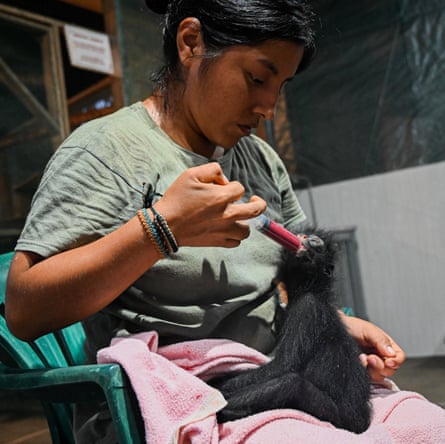[ad_1]
“She used to fight every time I tried to feed her, but she recognises it’s me now,” says Cinthia Pariguana-Garriazo, a veterinary nurse at Taricaya eco reserve. It is 6am, and she is coaxing a squealing baby spider monkey called Rain into accepting breakfast – a syringe filled with liquefied fruit and medicine.
Rain is fed every four hours and requires regular physical contact with Pariguana-Garriazo, her primary carer. Over the next few months, she will be gradually introduced to solid food and to other spider monkeys and her contact with humans will dwindle. From there, it’s a long process of rehabilitation before her release back into the wild. Juveniles can expect to stay at Taricaya for at least three years.
Taricaya is one of two rescue centres in Peru’s Madre de Dios region, one of the most biodiverse areas in the world. It is a dream destination for wildlife lovers, with 8.5m hectares (21m acres) hosting the world’s greatest concentration of bird species, as well as healthy populations of jaguar, tapir and ocelot.

But despite its ecological significance, the area has faced extensive destruction over recent decades, with an estimated loss of 130,000 hectares of tree cover between 2000 and 2020, according to Global Forest Watch.
Illegal gold mining is particularly problematic. The promise of riches has attracted thousands of migrant workers, who clear swathes of forest in search of tiny flecks of the precious metal. Mercury is often used to separate the gold from other minerals, and an estimated 185 tonnes of it seeps into the region’s rivers, soil and lakes every year.
On the frontline of this environmental crisis are the species who call the Peruvian Amazon home. “Usually it’s incidental,” says Fernando Rosemberg, director at Taricaya, who left the mining industry to work in conservation more than 20 years ago. “When miners go deep into the forest they can stay there for weeks. They might survive off the bushmeat from poaching monkeys. If they find the babies, they are kept as pets.” Rain was found being traded in a market and was confiscated by local environmental police before being brought to Taricaya. Spider monkeys were locally extinct until 2010, when Taricaya began reintroducing them to the wild.
Two hours upstream by boat is Amazon Shelter, the region’s other sanctuary. It is run by Magali Salinas, who quit her job 17 years ago and bought a plot of land on the outskirts of the region’s capital, Puerto Maldonado. “When the animals come to us they can be in a terrible condition,” says Salinas. “Many of them don’t make it.”
While Taricaya has a programme specifically for spider monkeys, Amazon Shelter focuses on howler monkeys. “After they poach the mothers, the miners might carry the babies in their pockets or feed them human foods like fried chicken,” says Salinas. The juveniles who reach her care are usually traumatised. “They see their mothers killed in front of them, so we have to earn their trust.”

While the sanctuaries work on the rehabilitation and release of the animals back into the wild, the environmental police service, Serfor (Servicio Nacional Forestal y de Fauna Silvestre), is responsible for rescuing them. “The most common pets we find are primates,” says Rodrigo Espinoza, a wildlife forestry specialist at Serfor. “People seem to like them because of their closeness to humans.”
The problem, he says, is that while monkeys can make good pets as babies, as they grow older they become more aggressive. Adolescent animals are either confiscated or handed in voluntarily when the owners realise how difficult it is to care for a grown animal. Some are killed.
Espinoza’s team also confiscates wildlife parts found at urban markets. Skins, shells and teeth are common, despite their commercial trade being illegal in Peru.
The sanctuaries aim to eventually release all animals back into the wild. With some, such as sloths and porcupines, it is just a case of relocation and release. But with primates it is more complicated.
“It’s a lot of work because monkeys are social,” says Rosemberg. “We have to teach them the skills they would have learned from their mothers.”
Monkeys are slowly introduced to each other to form small groups, replicating the social dynamics in the wild. Volunteers devise activities that require the monkeys to use tools that would normally be learned from other family members.
Once a group is ready for release, the animals go through extensive health checks to ensure they don’t pass on diseases to local species. A suitable forest location is carefully chosen for release, away from the territories of existing monkey troops, which could result in clashes.

Since 2009, Taricaya has released more than 400 animals into the wild, but the team sees no letup in their work. “We are not stopping mining, poaching or habitat loss,” says Rosemberg, “but at least we can give the animals a second chance.”
Find more age of extinction coverage here, and follow biodiversity reporters Phoebe Weston and Patrick Greenfield on Twitter for all the latest news and features
[ad_2]
Source link
